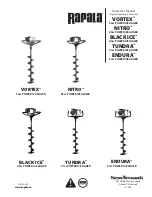
Torrey Pines Scientific, Inc.
27
XII. TEMPERATURE CALIBRATION
In the factory, a NIST traceable calibration is performed on all SC25* units before they are
shipped. The units utilize a two-point calibration algorithm and are calibrated at 4C for the
low temperature calibration point, and 95C for the high temperature calibration point. The
external temperature measurements are taken at the center of the top plate surface on the
SC25 unit. If the user has not recalibrated the unit, the factory calibration offsets are
retrieved from memory each time the unit is powered up. The calibration feature in the
menu of the SC25 enables the user to re-calibrate the unit at the center of the plate as was
done in the factory, or to calibrate the unit relative to some other location of interest. When
the unit has been calibrated by the user, the new user calibration offsets will be retrieved
from memory at power up. The original factory calibration offsets can be easily restored
anytime using the menu function “Reset Cal Points”, which will also erase any user set
calibration points.
Default operation uses two-point calibration to ensure accuracy across the entire settable
range. The user may perform a two-point calibration at different temperatures and different
locations if desired. It also is possible for the unit to operate using single-point calibration.
Details on both are provided below. The choice is based on the requirements of the user’s
specific process. If it is important for multiple temperatures in a range to be accurate, then
two-point calibration should be done with the low and high calibration temperatures equal to
the corresponding low and high temperatures in the expected range. If operation at only a
single temperature is required, then single-point calibration may be appropriate with the
understanding that displayed and measured temperature values will only match at the
single calibration temperature and not at other temperatures. Executing the menu function
“Reset Cal Points” will erase any user set single-point calibration and return the unit to the
default two-point calibration.
It is important to note that user calibration requires the unit to be stable at the calibration
temperature for a minimum of 10 minutes and potentially much longer depending on the
particular system. Also, the tool used for measuring the temperature at the point of interest
must be appropriate, accurate, and repeatable. For example, when measuring the
temperature of a surface, a capable surface temperature probe must be used and the
location of the measurement must be consistent. If an immersion probe is used in a liquid,
the fluid volume and the depth and location of the probe in the fluid must be consistent.
Typically, consistent and accurate temperature measurement requires a skilled technique
by the user regardless of the method or hardware used. Variation in the measurement of
the temperature at the low or high calibration points will affect the temperature
measurement accuracy across the entire range of the unit so care must be taken both
during the calibration process and during verification of the calibration.
Two-Point User Calibration
Proper two-point calibration requires the unit to be calibrated by the user at both a low
temperature and a high temperature. After calibration, the control algorithm inside the SC25
















































